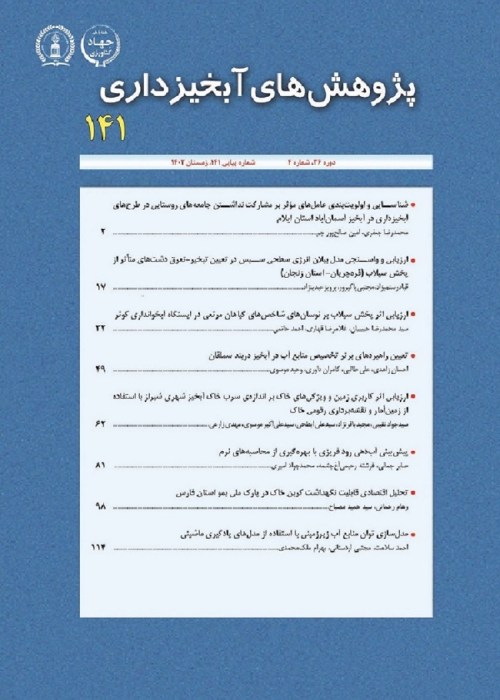Estimation of Soil Erodibility (K-factor) in Iran Using SoilGrids and HWSD Spatial Databases
Iran is one of the countries that soil erodibility is becoming one of the acute environmental problems and every year millions of tons of fertile soil are left unusable due to lack of proper management. In order to effectively protect and prevent the adverse effects of soil erosion, it is necessary to identify the factors affecting soil erosion and provide an appropriate estimate of their amount in the country. In this regard, the present study was conducted to estimate soil erodibility (K-factor) for a soil depth of 0-30 cm in Iran.
For this purpose, two database were used, including the Harmonized World Soil Database (HWSD) and global gridded soil information (SoilGrids), as well as RStudio and ArcGIS software. First, SoilGrids data was prepared at four depths of 0, 5, 15 and 30 cm and averaging was done. Also, the HWSD database was received in vector format for a depth of 0 to 30 cm. Finally, these data have been used to estimate the erodibility factor based on the soil content of organic carbon, clay, sand and silt using the EPIC equation. Finally, Relative Error (RE), Median Absolute Deviation (MAD) and Root Mean Square Error (RMSE) were calculated to compare two databases.
Assessments indicate that the average percentage of clay particles in the sub-basins of Iran varies between 15 and 32% and the average for the whole country is 23%. On the other hand, the average percentage of silt particles in the sub-basins of Iran varies between 19 and 45%, and the average for the whole country is 32%, among which the maximum and minimum percentage of silt particles are in the sub-basins of Qarasu-GorganRoud and Kavir Lut, respectively. Also, the average percentage of sand particles in the sub-basins of Iran varies between 28 and 65, and on the other hand, the average for the whole country is 44%, the minimum of which is related to the sub-basin of Karkheh and the maximum is related to the sub-basin of Kavir Lut. In Gavkhouni and Kavir Lut sub-basins, the reason the low soil erodibility factor is the high percentage of sand in these sub-basins, so that the percentage of sand in the Lut and Gavkhouni basins is 65 and 47% of the total soil particles, respectively. Considering that the average percentage of organic carbon in the sub-basins of Iran varies between 0.3 and 3.9, respectively, these values are related to the sub-basins of Hamun-e-Hirmand and Sefidroud-Haraz, so it can be said that the majority of the country's sub-basins are in poor conditions in terms of the percentage of organic matter. The results show that the southwestern, western and northeastern parts of the country have the maximum amount of soil erodibility factor, and the central Iran and desert parts of Iran have lower erodibility due to having a higher percentage of sand particles. Also, the results show that the lowest average amount of soil erodibility at the sub-basin scale using SoilGrids data with a value of 0.033 (ton*h/Mj*mm) is related to Lut Desert and also its maximum value is 0.045 (ton*h/ Mj*mm) related to it is the sub-basin of Haleh. In addition, the maximum and minimum values of the erodibility index with the HWSD data as an average of the basins of Iran are corresponding to the Mand and Gavkhouni sub-basins, respectively, with values of 0.042 and 0.033 (ton*h/ Mj*mm). So, the results showed that the average soil erodibility factor in Iran using two the HWSD and SoilGrids databases was 0.036 and 0.038 (ton*h/ Mj*mm) respectively.
Conclusion and Suggestions:
The study of soil erodibility with the data of SoilGrids and HWSD at the sub-basins scale showed that the maximum and minimum RE in Atrak and South Balochestan sub-basins are 21 and 1 percent, respectively, and the amount of RE is about 5% for the country average; Therefore, it can be concluded that although the RE between the two databases is not high, SoilGrids data is a more suitable source for soil and water resource modeling due to its continuity and better spatial resolution. Finally, it should be said that although this database is modeled using a larger number of profiles (about 150,000 soil profiles in the world), so they have appropriate accuracy. However, it is necessary to state that investigating the uncertainty of these data in order to improve the results of this database in order to improve the results of that in different parts of the country is recommended to researchers and researchers. Also, it is noteworthy that the EPIC model was used to estimate soil erodibility in this study, while its evaluation and comparison with other soil erodibility estimation models in the country is suggested to other researchers and experts.
- حق عضویت دریافتی صرف حمایت از نشریات عضو و نگهداری، تکمیل و توسعه مگیران میشود.
- پرداخت حق اشتراک و دانلود مقالات اجازه بازنشر آن در سایر رسانههای چاپی و دیجیتال را به کاربر نمیدهد.


